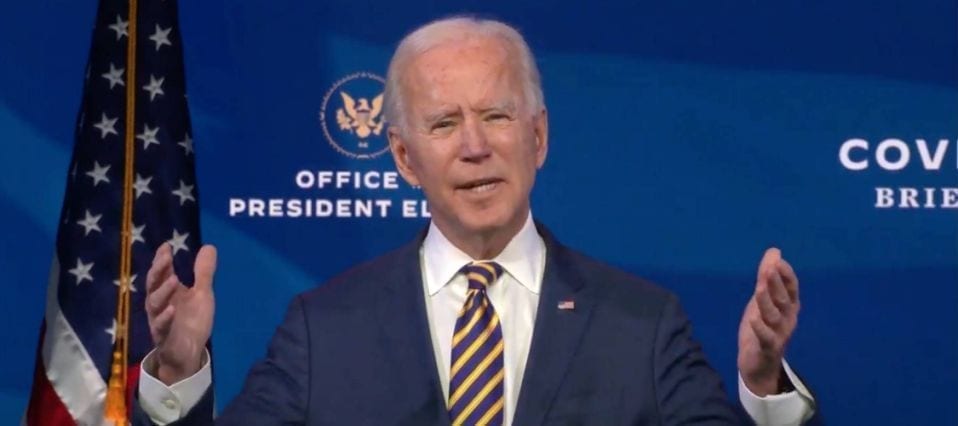The post Biden Presidency Promises Change for Power Industry appeared first on POWER Magazine.

As we get closer to the presidential inauguration, and with President-elect Biden’s announcement of his Cabinet picks for the Department of Energy (DOE), Environmental Protection Agency (EPA), and the Department of the Interior (Interior), we begin the inevitable hypothesizing about which “Day 1 actions” will be taken, which actions will be among the administration’s “100 Day actions,” and what priorities will bleed into 2022 or beyond.
COMMENTARY
President-elect Biden has put forth a sweeping platform during the campaign, a platform that if accomplished would completely transform the U.S. energy system within the next several decades by putting the country on a path to achieve net-zero emissions, economy-wide, by 2050, and to generate electricity from renewable sources in order to achieve a carbon pollution-free power sector by 2035. To achieve these goals, substantial technological advancement is required, including significant changes to the power generation, transmission, and distribution systems.

In addition, Biden’s picks for key energy and environmental Cabinet and leadership posts have also been progressive, clearly sending a signal that diversity will be embraced and communities that have been overlooked will have a seat at the table. But what does all of this mean for actual policy initiatives or regulatory action? Here are our some of our predictions for Day 1 actions and beyond, with a focus on the utility sector.
Rejoin Paris Agreement
On Day 1, we can expect that the U.S. will begin taking steps to rejoin the Paris Climate Agreement. In addition, expect to see a repeal of Executive Order (EO) 13783, “Promoting Energy Independence and Economic Growth.” In this EO, President Trump rescinded several previous presidential actions that focused on addressing climate change. In revoking EO 13783, Biden could simply reinstate rescinded EO 13653, “Preparing the U.S. for Impacts of Climate Change,” that sought to make the United States more climate resilient by modernizing federal programs and interagency sharing of data and information. He could also look to reinstate the June 25, 2013, Presidential Memorandum regarding Power Sector Carbon Pollution Standards that sought to address carbon pollution from the power sector, or the Sept. 21, 2016, Presidential Memorandum regarding Climate Change and National Security that ensured climate impacts are fully considered in the development of national security doctrine.

Most certainly, the disbanded interagency working group on the social costs of greenhouse gases (GHG) will be reinstated, in some form or another, among other Day 1 actions related to climate. Given Biden’s selection of John Kerry as his special presidential envoy for climate, and Gina McCarthy as the first-ever national climate adviser—two extremely well-versed experts on all things climate policy-related (and neither have to be confirmed by the Senate), combined with EPA pick Michael Regan and Interior’s Deb Haaland, it is extremely safe to say that once the focus shifts past the current COVID-19 and economic crisis, all attention will be on interweaving climate throughout the entirety of the federal government.
Emissions Regulations
Moving into the first 100 days, the EPA has dozens of Trump rollbacks to choose from, but no regulation has greater impact on the existing utility sector than the now-dead Clean Power Plan (CPP) and the Affordable Clean Energy (ACE) regulation that was stood up in its place. Will CPP/ACE become the ultimate ping-pong regulation? With the Obama-era CPP never going into effect due to court action, and then rescinded by ACE—and with ACE itself still mired in legal action—what will become of this rule? Assuming the rule survives the legal challenges, the Biden administration will surely want to repeal and replace it.
But will it even matter? The utility sector is already moving forward with its own carbon dioxide reductions—Edison Electric Institute members are on target to reduce emissions by 50% by 2030 from 2005 levels. With 70% of the electric sector moving quickly to reduce GHG emissions, is there a need by the EPA to fast-track a new regulation?
The retirement of coal-fired power plants in the U.S. will likely take years via a new rule or regulation. Instead, perhaps this new administration should just rely on the markets to retire coal-powered plants by incentivizing their retirements? In tackling climate change, the most aggressive targets have been placed on the power generation sector, but much remains to be seen as to how fast this sector can actually move to hit these aggressive targets given the technical constraints and regulatory environment.
Environmental Justice
Another action we can expect to see within the first 100 days is an emphasis on environmental justice. Both Regan and Haaland have track records in this arena, and in fact, Haaland held meetings with tribal leaders in December regarding environmental injustice. Expect to see both EPA and Interior focus on safeguarding communities from increases in pollution from new power plants and other potential pollution-emitting sources, and also focus on environmental justice by not granting permits to areas already deemed “overburdened” by existing pollution.
Interior has several items on its Day 1 through Day 100 to-do list, but with the utility sector in mind, the focus will be on developing as much renewable energy as possible on federal lands and waters. Targets have been established in Biden’s platform to aggressively promote renewable energy from federal lands—which will primarily come from solar and hydro sources, but there are also opportunities for wind and geothermal energy production on federal lands in the West. However, offshore wind is a significant focus for the administration, as it is expected that the administration will set an ambitious target of producing 30 GW of wind energy from the Outer Continental Shelf by 2030.
To speed along reaching these targeted goals and policy objectives, expect to see a carrot-and-stick approach with both tax credits and other incentives used to move these initiatives forward. In fact, it will be hard for Biden to reach his goals without the market putting pressure on the industry to change, and it is expected that the financial market will continue to put pressure on companies via environmental, social and corporate governance ratings as well as divesting from fossil fuels.
Actual Implementation
All these issues are to be expected, and it’s easy to issue an EO or put forth a lofty goal—but the real progress comes in the “beyond,” where these ideals actually get implemented. How fast can we permit new transmission line corridors to serve new renewable energy generation on federal lands and offshore, where there is barely any existing infrastructure? Will we continue to see protests for the establishment of rights-of-way for needed new energy infrastructure? Or will communities stand down in support of renewable energy projects in the name of climate change?
With reports by the Energy Information Administration (EIA) that the United States only grew 2% in the renewable energy sector in 2020, and EIA estimating only another 1% of growth in 2021, how fast can this sector grow to meet the existing demand, combined with new demand from electric vehicles, and without increasing energy prices for consumers or sacrificing reliability?
President-elect Biden, in choosing Kerry, McCarthy and Regan, has selected seasoned climate policy experts who have gone through this battle before. The challenge is whether they can take their Day 1 statements and turn them into policies that will last beyond the next four to eight years.
—Elizabeth “Liz” Leoty Craddock is special counsel and a member of the government relations team at Jones Walker LLP. Jim Noe is a partner in Jones Walker LLP’s Government Relations Practice Group and a member of the Energy, Environmental & Natural Resources Industry team.
The post Biden Presidency Promises Change for Power Industry appeared first on POWER Magazine.
POWER Magazine